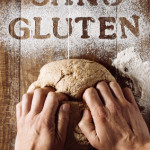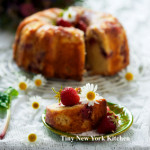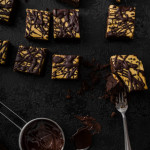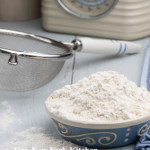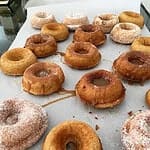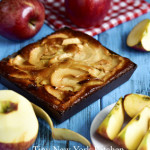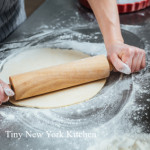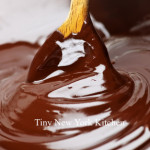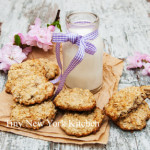We love autumn, but we’re giving it one last-ditch effort to savor the remaining glimmers of summer. You may frost this cake or leave it plain.
Sometimes I Just Get In An Uncontrollable Baking Mood. Baking Brownies Is One Of My Favorite Things To Do.
This Snowy Saturday Morning I’m Making Old-Fashioned Baked Donuts. YUM!
“Work With What You Got!”
©Tiny New York Kitchen © 2018 All Rights Reserved
I like to bake all year long, but baking season is officially here!
Whether you’re baking summer pies or getting ready for holiday baking it’s important to have some key information about pie dough.
Blind Baking
Blind baking is prebaking a crust before you add an unbaked or especially wet filling. To ensure that your crust turns out crisp while blind baking, you can either dock it or use pie weights.
Docking
Docking is pricking the dough all over with the tines of a fork. The tiny holes allow steam to escape, so that the crust doesn’t puff up. After rolling out your dough and pressing it into the pan, gently prick it, leaving an inch or two between each mark. Be sure to check your crust several times throughout its bake time. If you notice it puffing up in any way, simply prick the puffy spots a few times and keep baking.
Pie Weights
Pie weights are tiny ceramic or metal balls or a thin metal chain that prevent the bottom of your crust from forming air pockets and bubbling up while baking. While docking is less fussy than using pie weights, I prefer pie weights because of the additional support they give the crust. Line your unbaked crust with parchment paper or aluminum foil before adding the weights to keep them from baking into the dough. I prefer parchment paper because its permeable structure allows the crust to breathe and brown more evenly. If you don’t own pie weights, dried beans work just as well.
Blind Bake Ahead
You can blind bake a crust up to three days ahead of time. Allow the crust to cool completely in the pan, wrap with plastic wrap, and store at room temperature until you are ready to fill and serve.
Happy Pie Baking!
“Work With What You Got!”
© Victoria Hart Glavin Tiny New York Kitchen © 2017 All Rights Reserved
Even though summer is not technically over I’m in the fall baking mood. Yesterday was a rainy day here in New England. I made Gooey Rocky Road Brownies and I had to stop myself from eating the entire batch.
From Concord to Emperor, there are so many delicious grape varieties available.
Whether tossed in a salad, baked into a dessert, or straight off the vine, these bite-size globes are packed with flavor.
Bursting with fiber, vitamin C, and loads of antioxidants, this fruit packs a nutritional punch as big as flavor. Grapes make an ideal portable snack in less than 100 calories per cup.
Look for firm grapes that are brightly colored and securely attached to their stems. Avoid bundles with wrinkled, dull skin or packages that have a lot of fruit floating at the bottom of the bag. When all else fails, try one.
Although there are thousands of varieties of grapes, the most popular are Thompson and Emperor seedless. Thompson grapes are sweet and crisp with vibrant green skin, amazing for snacking. Emperor red grapes have a sweet and tart flavor and are super juicy, making them great for baking.
Emperor or Flame: With their sweet flavor and long shelf life, these large seedless grapes are one of the most popular varieties.
Thompson Green: In America, 90% of these classic green grapes are produced in California. They are used for snacking, making wine, and raisins.
Concord: Created in Concord, Massachusetts, these grapes are known for their thick, blush skin and sweet candy-like flavor.
Freeze Them: Pick grapes off the vine and place them in a resealable plastic bag. Freeze overnight for a healthy, frosty treat.
Bake Them: To make raisins at home, cook grapes for 30 seconds in boiling water and place in a bowl of ice water. Preheat the oven to 170 degrees and place grapes on a parchment paper lined baking sheet. Bake until they have dried out completely. Toss grapes halfway through to prevent sticking.
Blend Them: Blend grapes with a bit of water and pour through a fine mesh strainer for a fresh glass of grape juice.
“Work With What You Got!”
© Victoria Hart Glavin Tiny New York Kitchen © 2017 All Rights Reserved

